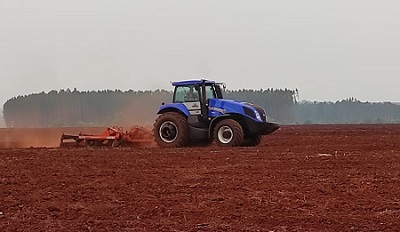Reduced planting system influencing on soil nutrient contents and sugarcane yield: a study in Nova Alvorada do Sul, MS
DOI:
https://doi.org/10.20873/jbb.uft.cemaf.v10n2.lanzaKeywords:
preparation systems, sustainability, soil revolving, Saccharum sp.Abstract
The benefits of the non-revolving soil system for grain cultivation are widely known. This study aims to monitor the effect of planting systems on sugarcane yield and quality, and its influences on soil nutrient contents. A study was carried out during 2019 and 2020, and compared three sugarcane planting systems based on: (i) conventional planting, (ii) reduced planting, (iii) and planting without soil disturbance. Data collections of soil and sugarcane samples (yield and quality parameters) were carried out in the first year of harvest (plant cane) and the first ratoon. Results showed that the reduced planting system promoted an increase in sugarcane yield in short term than conventional planting and planting without soil disturbance. The quality parameters of sugarcane were not affected by planting systems. More studies are requested to compare and explain the sugarcane planting systems and their effect on soil conditions, mainly in long term.
References
Almeida RF, Mikhael JEF, Franco FO, Santana LMF, Wendling B. Measuring the labile and recalcitrant pools of carbon and nitrogen in forested and agricultural soils: a study under tropical conditions. Forests, v.10, n.7, p.1-11, 2019. https://doi.org/10.3390/f10070544
Almeida RF, Silveira CH, Mota RP, Moitinho Mara, Arruda EM, Mendonça ES, La Scala N, Wendling B. For how long does the quality and quantity of residues in the soil affect the carbon compartments and CO2-C emissions? Journal of Soils and Sediments, v.16, p.2354-2364, 2016. http://dx.doi.org/10.1007/s11368-016-1432-3
Arcoverde SNS, Souza CMA, Suarez AHT, Colman BA, Nagahama HJ. Atributos físicos do solo cultivado com ca-na-de-açúcar em função do preparo e época de amostragem. Revista de Agricultura Neotropical, v.6, n.1, p.41-47, 2019. https://doi.org/10.32404/rean.v6i1.2761
Arcoverde SNS, Souza CMA, Nagahama HJ, Mauad M, Armando EJ, Cortez JW. Growth and sugarcane cultivars productivity under no tillage and reduced tillage system. Re-vista Ceres, v.6, n.3, p.168-177, 2019. https://doi.org/10.1590/0034-737X201966030002
Arcoverde SNS, Souza CMA, Armando EJ, Gonçalves MC, Santos WR. Multivariate analysis of sugar cane cultivars yield under two soil preparations systems. Energia na Agri-cultura, v.34, n.1, p.28-39, 2019. https://doi.org/10.17224/EnergAgric.2019v34n01p28-39
Baquero JE, Ralisch R, Conti M, Tavares Filho C, Guimarães MF. Soil physical properties and sugarcane root growth in a red oxisol. Revista Brasileira de Ciência do Solo, v.36, n.1, p.63-70, 2012. https://doi.org/10.1590/S0100-06832012000100007
Carvalho LA, Silva Junior AA, Nunes WAGA, Meurer I, Souza Júnior WS. Produtividade e viabilidade econômica da cana-de-açúcar em diferentes sistemas de preparo do solo no Centro-oeste do Brasil. Revista de Ciências Agrárias, v.34, n.1, p.200-211, 2011. https://doi.org/10.19084/rca.15942
CONAB - Companhia Nacional de Abastecimento. Boletim da safa da cana-de-açúcar. 2021. Avaliable at https://www.conab.gov.br/info-agro/safras/cana/boletim-da-safra-de-cana-de-acu-car/item/download/32979_88b84286b1b3ca8a99aaaa5f7ae6d68c. Acessed on 01 December 2021.
EMBRAPA - Empresa Brasileira de Pesquisa Agropecuária. Manual de métodos de análise de solo. Brasília: Embrapa, 577p. 2017.
Fernandes AB, Queiroz AC, Pereira JC, Lana RP, Barbosa MHP, Fonseca DM, Detmann DM, Cabral LS, Pereira ES, Vittori A. Chemical composition of sugarcanevarieties (Sac-charum spp. L.) with different production cycles (preco-cious and intermediate) at three cutting ages. Revista Brasi-leira de Zootecnia, v.32, n.4, p.977-985, 2003. https://doi.org/10.1590/S1516-35982003000400025
Lopes CM, Silva AMM, Estrada-Bonilla GA, Ferraz-Almeida R, Vieira JLV, Otto R, Vitti GC, Cardoso EJBN. Improving the fertilizer value of sugarcane wastes through phosphate rock amendment and phosphate-solubilizing bacteria inocu-lation. Journal of cleaner production, v.298, p.1-11, 2021. https://doi.org/10.1016/j.jclepro.2021.126821
Marangoni FF, Otto R, Almeida RF, Casarin V, Vitti GC, Tiritan CS. Sources of zinc and boron on sugarcane yield in southeast Brazil. Sugar Tech, v.21, p.917-924, 2019. https://doi.org/10.1007/s12355-019-00716-x
Oliveira ECA, Freire FJ, Oliveira RI, Santos RBG, Simões Neto DE, Silva SAM. Extração e exportação de nutrientes por variedades de cana-de-açúcar cultivadas sob irrigação plena. Revista Brasileira Ciência do Solo, v.34, n.4, p.1343-1352, 2010. https://doi.org/10.1590/S0100-06832010000400031
Otto R, Netto GJMS, Ferraz-Almeida R, Altarugio LM, Fava-rin JL. Multisite response of sugarcane to nitrogen rates and split application under Brazilian field conditions. Agronomy Journal, v.113, n.1, p.419-435, 2021. https://doi.org/10.1002/agj2.20461
Santos Junior JDG, Sá MAC, Oliveira CM, Franz CAB, Rein TA, Sousa DMG. Sistema Plantio Direto de cana-de-açúcar no Cerrado. Circular técnica. Planaltina: Embrapa, 8p. 2015.
Silva Junior CA, Carvalho LA, Centurion JF, Oliveira ECA. 2013. Comportamento da cana-de-açúcar em duas safras e atributos físicos do solo, sob diferentes tipos de preparo. Biosciencie Journal, v.29, n.1, p.1489-1500, 2013.
Souza GS, Souza ZM, Silva RB, Araújo FS, Barbosa RS. Compressibilidade do solo e sistema radicular da cana-de-açúcar em manejo com e sem controle de tráfego. Pesquisa Agropecuária Brasileira, v.47, n.4, p.603-612, 2012. https://doi.org/10.1590/S0100-204X2012000400017

Downloads
Published
How to Cite
Issue
Section
License
Copyright (c) 2022 Nilson Lanza, Risely Ferraz-Almeida

This work is licensed under a Creative Commons Attribution 4.0 International License.
Copyright (c) 2024 - Journal of Biotechnology and Biodiversity

This work is licensed under a Creative Commons Attribution 4.0 International License.
Authors who publish with this journal agree to the following terms:
Authors retain copyright and grant the journal right of first publication with the work simultaneously licensed under a Creative Commons Attribution License (CC BY 4.0 at http://creativecommons.org/licenses/by/4.0/) that allows others to share the work with an acknowledgement of the work's authorship and initial publication in this journal.
Authors are able to enter into separate, additional contractual arrangements for the non-exclusive distribution of the journal's published version of the work (e.g., post it to an institutional repository or publish it in a book), with an acknowledgement of its initial publication in this journal.
Authors are permitted and encouraged to post their work online (e.g. in institutional repositories or on their website) prior to and during the submission process, as it can lead to productive exchanges, as well as earlier and greater citation of published work (Available at The Effect of Open Access, at http://opcit.eprints.org/oacitation-biblio.html).


